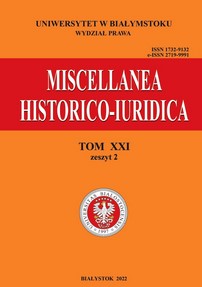Major dr med. Ludwik Krzewiński – twórca polskiej narkoanalizy
Ludwik Krzewiński – Creator of Polish Narcoanalysis
Author(s): Jan WidackiSubject(s): Security and defense, Experimental Pschology
Published by: Wydawnictwo Uniwersytetu w Białymstoku
Keywords: narcoanalysis; Independent Technical Department of the 2nd Division; counterintelligence of the Second Polish Republic; Ludwik Krzewiński;
Summary/Abstract: Several recent publications first mentioned (see: T. Dubicki, Samodzielny Referat Techniczy (SRT) Oddziału II Sztabu Generalnego (Głównego) Wojska Polskiego. Geneza, organizacja, personalia, [in:] Sekretna wojna, Z dziejów kontrwywiadu II RP, ed. Z Nawrocki, Poznań 2015) and later described (Widacki, J., The use of narcoanalysis by Polish counterintelligence in the 1930s, “European Polygraph” 2021, vol. 15, No. 1 (53), pp. 41-51; Idem: Stosowanie narkoanalizy przez polski kontrwywiad w okresie międzywojennym, “Studia z Dziejów Państwa i Prawa Polskiego” 2021, vol. 24, 13-30) how the Second Department of the General Staff of the Polish Armed Forces used narcoanalysis (“injections debilitating the will”) for counterintelligence purposes in the 1930s. Captain Ludwik Krzewiński, MD, is believed to have been the creator of Polish narcoanalysis, as he designed both the recipes and the technique of their application. Little was known and written about the officer himself, as he even has no separate entry in T. Dubicki and A. Suchcitz’s fundamental four-volume biographical dictionary (Oficerowie wywiadu WP i PSZ w latach 1939–1945, Warszawa–Łomianki, 2009–2019). However, the life history of Krzewiński, and especially the remarkable fate of that officer of the Second Department of the General Staff in the wake of the September 1939 campaign, has as yet not been analysed by the historians of Polish intelligence. Its investigation required examining archives stored both in Poland (Central Military Archives, Archives of New Records (AAN), the State Archive in Warsaw, and the archives of the Institute of National Remembrance) and in the US, as well as inclusion of accounts by members of Krzewiński’s family discovered in the United Kingdom. This article is the product of the research described above.
Journal: Miscellanea Historico-Iuridica
- Issue Year: 21/2022
- Issue No: 2
- Page Range: 203-222
- Page Count: 20
- Language: Polish

